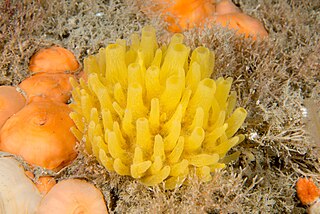
The Clathrinida are an order of calcareous sponges found in marine environments. These sponges have an asconoid structure and lack a true dermal membrane or cortex. The spongocoel is lined with choanocytes.

Polymastia is a genus of sea sponges containing about 30 species. These are small to large encrusting or dome-shaped sponges with a smooth surface having many teat-shaped projections (papillae). In areas of strong wave action, this genus does not grow the teat structures, but instead grows in a corrugated form.

Halichondriidae is a family of sea sponges belonging to the order Suberitida. These sponges have a skeleton consisting of dense bundles of spicules occurring in a more or less random pattern.

Homosclerophorida is an order of marine sponges. It is the only order in the monotypic class Homoscleromorpha. The order is composed of two families: Plakinidae and Oscarellidae.
Clathrina multiformis is a species of calcareous sponge from Russia.
Racekiela ryderi is a species of freshwater sponge in the family Spongillidae. It was first described by Edward Potts in 1882. It was collected on Sable Island in 1899 by John Macoun, a biologist with the Geological Survey of Canada, and given the name Heteromeyenia macouni by A.H. Mackay in 1900. It was originally assumed to be endemic to Sable Island but is now considered to be the same species as Racekiela ryderi, which is more broadly distributed.

Ancorinidae is a family of marine sponges belonging to the order of Tetractinellida.
Homaxinella is a genus of sea sponges in the family Suberitidae. The type species is Homaxinella balfourensis.

Dictyoceratida is an order of sponges in the subclass Ceractinomorpha containing five families. Along with the Dendroceratida, it is one of the two orders of demosponges that make up the keratose or "horny" sponges, in which a mineral skeleton is minimal or absent and a skeleton of organic fibers containing spongin, a collagen-like material, is present instead.
Guancha apicalis was thought to be a species of calcareous sponge in the genus Guancha from Antarctica. It actually never existed.
Tethyida is an order of sea sponges in the subclass Heteroscleromorpha.

Agelasida is an order of sea sponges in the class Demospongiae.
Merliida is an order of demosponges in the subclass Heteroscleromorpha, first described as such by Jean Vacelet in 1979.

Spongillida is an order of freshwater sponges in the subclass Heteroscleromorpha.
Baeriidae is a family of calcareous sponges in the class Calcarea. It was named by Borojevic, Boury-Esnault, and Vacelet in 2000. The type genus is BaeriaMiklucho-Maclay, 1870, by original designation, though Baeria is now considered a junior synonym of LeuconiaGrant, 1833.

Heteropia glomerosa is a species of calcareous sponge in the family Heteropiidae, and was first described as Leuconia glomerosa in 1873 by James Scott Bowerbank. In Australia, the species is found in the IMCRA regions of the Central Western Shelf Transition, Central Western Shelf Province, Northwest Province, and the Central Western Transition.

Bubaridae is a family of sponges belonging to the order Bubarida. It has a cosmopolitan distribution.

Phakellia is a genus of sponges belonging to the family Bubaridae. The genus has a cosmopolitan distribution.
Phycopsis is a genus of sponges belonging to the family Axinellidae. The species of this genus are found in Malesia and Australia.










